Part 1

Children’s Learning through the Arts



The Arts significantly boost student achievement, reduce discipline problems, and increase the odds students will go on to graduate from college. As First Lady Michelle Obama sums up, both she and the President believe ‘strongly that Arts education is essential for building innovative thinkers who will be our nation’s leaders for tomorrow’.
Arne Duncan, Former U.S. Secretary of Education
The Early Years Learning Framework (EYLF) outlines the purpose of early years education as engaging and developing the whole child. The ‘whole child’ concept encompasses children’s beliefs and values, their inner world of the mind, imagination and spirit, their personality and physical capabilities, and their social and cultural world. The goal of engaging and developing the whole child is expressed in EYLF in terms of children’s belonging, being and becoming.
The expectations of the school curriculum are outlined in the Australian Curriculum and cover the early childhood schooling years of Foundation to Year 3. In the Australian Curriculum, the Arts is one of the compulsory Learning Areas. ‘The Arts’ in this context means Dance, Drama, Media Arts, Music and Visual Arts. The goal of the curriculum in the Arts Learning Area is to engage children in exploring, creating, expressing ideas and communicating through the various embodied, multimodal and practical ways provided by the Arts.
The EYLF promotes a play-based approach to learning, which, with its emphasis on child-centred learning through discovery and inquiry, is reflected in the precepts of Arts Education and the expectations of the Arts Learning Area in the Australian Curriculum. While there is a growing focus in education circles on literacy, numeracy and Science, Technology, Engineering and Mathematics (STEM) subjects, it is important to remember that a learning program rich in arts engagement contributes significantly to children’s learning and their development as individuals: their sense of self, their agency, their wellbeing and their dispositions for learning.
In Part 1 we explore what children’s learning through the Arts looks like. We begin in Chapter 1 by outlining the expectations of EYLF and the Australian Curriculum, in order to provide a context for the propositions in this text. In Chapter 2, we describe the features of arts-based learning. In Chapter 3, we describe how engagement in the Arts contributes to the development of the whole child in a sociocultural context. In Chapters 4, 5 and 6, we take each of the EYLF framing ideas to show how learning through the Arts off ers a powerful model for children’s belonging, being and becoming.
OXFORDUNIVERSITYPRESSSAMPLEONLY




OXFORDUNIVERSITYPRESSSAMPLEONLY




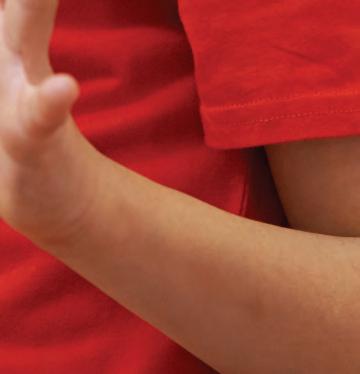

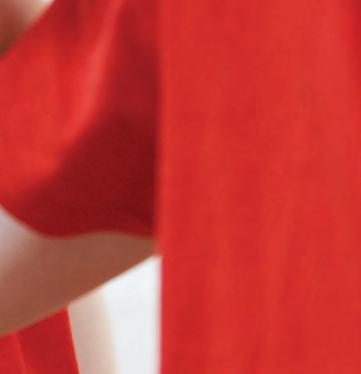
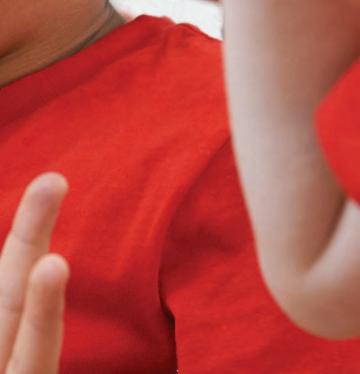




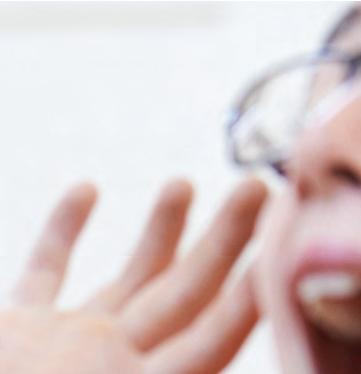

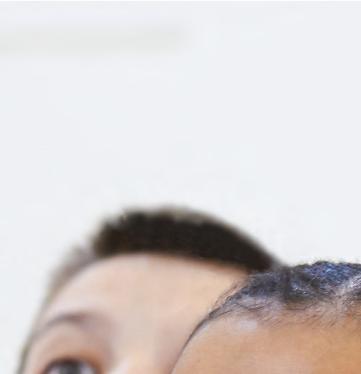
OXFORD
UNIVERSITY PRESS
Setting the Context
Let the child go and come freely, let him touch real things and combine his impressions for himself, instead of sitting indoors at a little round table, while a sweet-voiced teacher suggests that he build a stone wall with his wooden blocks, or make a rainbow out of strips of coloured paper, or plant straw trees in bead flowerpots. Such teaching fi lls the mind with artificial associations that must be got rid of, before the child can develop independent ideas out of actual experience.
Anne Sullivan, teacher of Helen Keller
CHAPTER OBJECTIVES

This chapter aims to set the context by providing an overview of:
» the policy and curriculum frameworks for early childhood education
» the Arts and their place within the Early Years Learning Framework (EYLF)
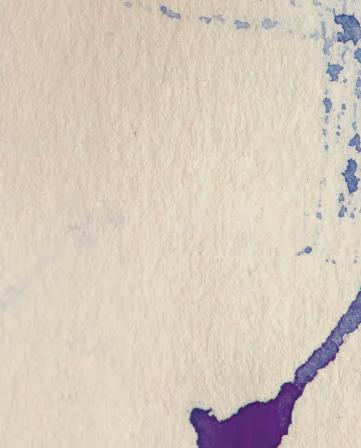
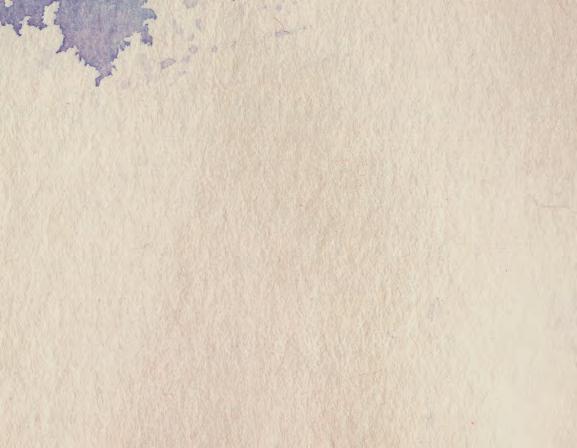



» the Arts Learning Area in the Australian Curriculum.
OXFORDUNIVERSITYPRESSSAMPLEONLY


OXFORD UNIVERSITY PRESS 1
Introduction
The early childhood sector of education spans from birth to age eight. Developmentally, these are the supercharged years of an individual’s growth. In Australia over the past decade, a considerable amount of attention has been given to the early years of children’s education and development. This is framed in part by the United Nations Convention on the Rights of the Child affirming that each child has the right to an education (CRIN, 2018a) that develops their ‘personality, talents and mental and physical abilities to their fullest potential’ (CRIN, 2018b). It has also been guided by compelling evidence from extensive international research about the high correlation between the quality of children’s early years and their ability to fulfil their potential in later life (Elliott, 2006; Heckman et al., 2013; Siraj-Blatchford, 2009). For parents, caregivers and educators, a young child’s educational development is a big responsibility. It is also a big responsibility for governments and policy makers who must consider each individual’s education in the context of the future prosperity, health and social cohesion of society.
The special and distinctive nature of early childhood education for children to the age of five is the way it focuses on the development of the whole child—the individual in their social and cultural milieu—through play-based pedagogy. The Early Years Learning Framework (EYLF), created by the Department of Education and Training (DET) in 2009 and updated in 2019, notes that play is seen as ‘a context for learning through which children organise and make sense of their social worlds, as they actively engage with people, objects and representations’ (DET, 2019, p. 6). Play-based pedagogy builds on young children’s innate learning practices by involving them in practical, imaginative, thoughtful, purposeful, interactive and creative explorations of their world and their place in it.
Anxieties about literacy and numeracy standards and children’s ‘school readiness’ have seen an increasing prevalence of formal schooling practices being adopted with younger and younger children (Jay, 2016). The incursion of formal school-style learning into the early childhood centre misunderstands the distinct character of the way that children learn in these early years of life (Gordon & Williams Browne, 2014; Jay, 2016; Wood & Attfield, 2005). Rather than being a ‘lite’ version of schooling, early childhood pedagogy is designed to develop the neural pathways, cognitive processing and physical aptitude that are the foundations for the development of capable, confident, caring and creative individuals who have the capability to adapt and thrive as they progressively adopt more of the practices of formal schooling when moving through the years of primary school. The precepts of playbased learning are still carried through into the school years but are adapted and merged with the curriculum imperatives that frame schooling from the Foundation year.
OXFORDUNIVERSITYPRESSSAMPLEONLY
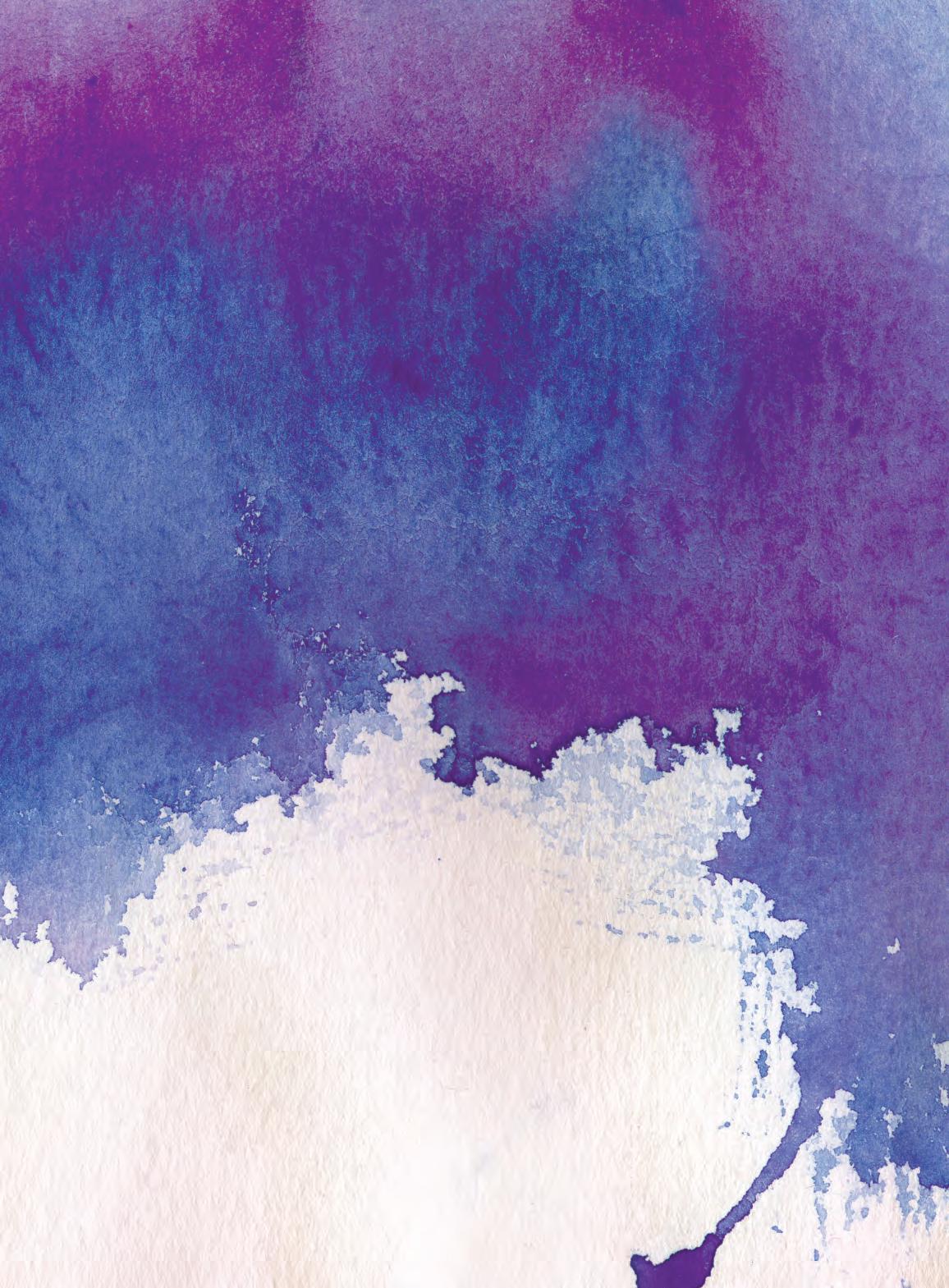
The policy and curriculum framework for early childhood education
In Australia, where early childhood is defined as the age span from birth to eight years, university-qualified early childhood educators potentially work within two educational frameworks—the Early Years Learning Framework (EYLF) (birth to aged five) and the
5 OXFORD UNIVERSITY PRESS CHAPTER 1 S ETT ing THE Con TE x T
Australian Curriculum (Foundation to Year 3). These sit within a suite of interconnected policy and curriculum documents that provides the framework for education in the early childhood sector.
TABLE 1.1 Key documents that frame education in the early childhood sector
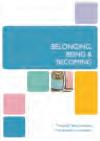

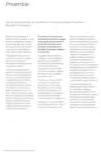
Melbourne d eclaration on Educational g oals for Young Australians

Each decade an educational declaration by the country’s Ministers of Education sets the educational goals for the coming decade. The Melbourne Declaration (2008) had two goals:
Goal 1: Australian schooling promotes equity and excellence.
Goal 2: All young Australians become:
» Successful learners
» Confident and creative individuals
» Active and informed citizens.
While the Melbourne Declaration has been superseded by the Alice Springs (Mparntwe) Education Declaration (2019), it is important to note that the Melbourne Declaration framed the development of the two curriculum frameworks that apply in the early childhood years: The Early Years Learning Framework (EYLF) and the Australian Curriculum. http:// www.curriculum.edu.au/verve/_resources/National_Declaration_on_the_Educational_Goals_for_Young_Australians.pdf Alice Springs (Mparntwe) Education d eclaration
The Alice Springs (Mparntwe) Education Declaration (2019) reaffirms the goals of the Melbourne Declaration and reiterates the importance of learning throughout life, from early childhood onwards. It emphasises the position of students at the centre of their education. It highlights the importance of meeting the individual needs of all learners and supporting their wellbeing, mental health and resilience, with special consideration for unlocking and developing the potential of Aboriginal and Torres Strait Islander children. There is a particular commitment to learning from—as well as celebrating—Aboriginal and Torres Strait Islander cultures, knowledge and histories. https://www.dese.gov.au/ alice-springs-mparntwe-education-declaration/resources/alice-springs-mparntwe-education-declaration national Quality Standards (nQS)
The National Quality Standards (NQS) is a product of the National Quality Framework (NQF), designed to support continuous improvement and consistency in early childhood education and care services. Each service provider is assessed against the NQS and is required to develop a Quality Improvement Plan and provide evidence of how they have addressed the standards. These standards are part of the matrix that shapes the early childhood learning experience and should be considered in tandem with EYLF. https://www.acecqa.gov.au/nqf/national-quality-standard
Australian Professional Standards for Teachers
The Australian Professional Standards for Teachers were developed by the Australian Institute of Teaching and School Leadership (AITSL). The seven standards are calibrated across the span of a teacher’s career with the expectation that graduate teachers demonstrate essential capabilities across all standards and are classroom ready. Developing a Portfolio of Evidence against the standards is a professional process in which all pre-service teachers should engage. www.aitsl.edu.au/australian-professional-standards-for-teachers
Australian Early Years l earning Framework for Australia (EY l F)

The Early Years Learning Framework (EYLF) is the first national framework for the sector and is described in Belonging, Being and Becoming: The Early Years Learning Framework for Australia (2019). It outlines the vision for young children’s learning from birth to five years of age, and their transition to school. It describes five principles, eight practices and five learning outcomes that reflect contemporary theories and research about early childhood education. https:// www.dese.gov.au/national-quality-framework-early-childhood-education-and-care-0/earlyyearslearningframework
OXFORDUNIVERSITYPRESSSAMPLEONLY
Australian Curriculum
The Australian Curriculum is a national curriculum for Foundation to Year 12 schooling. It comprises eight Learning Areas, including the Arts Learning Area, as well as General Capabilities and Cross-curriculum Priorities. It sets out curriculum expectations in terms of what content will be covered in the years of schooling and the achievement standards for each year. https://www.australiancurriculum.edu.au/
6 OXFORD UNIVERSITY PRESS PART 1 C H ild RE n’ S lEAR ning THR oug H THE A RTS
AITSL
The Arts in young children’s education
In a play-based pedagogy, learning through the Arts is a well-established feature—though the degree to which this is seen in the different early childhood centres does vary.
The significance of the Arts subjects of Dance, Drama, Media Arts, Music and Visual Arts is that they offer diverse and unique ways for young children to experience their world— the manifest world, the social world, the cultural world and the world of the imagination. By engaging in arts experiences, children are exploring and coming to know their world. For example, by dancing over, under and between, children come to know what these concepts mean through their direct experience of them. In this process they create meaning.
The Arts are forms of communication that complement linguistic language and writing. Children can show you the tempo and mood of the music through their dancing. They can show you the special people in their lives through their drawings. By responding and sharing their ideas, thoughts and feelings through their arts-making (e.g. dancing, musicmaking and drawing), children are communicating their sense or experience of the world. For educators, children’s arts-making is a special window into their world.
In both Australia and New Zealand, the Arts is a mandated Learning Area in the formal school curriculum. This means that from the Foundation year, educators are required to provide a coherent and developmental program of learning in the Arts in the same way they should for other nominated Learning Areas like English, Science and Maths. In the Maths Learning Area, you would expect to be engaged in developing children’s comprehension of maths concepts like addition and multiplication; their facility with maths processes such as creating graphs; along with their critical thinking and problem-solving skills through well-designed learning activities. The same applies to the Arts Learning Area where you will be similarly engaged in developing children’s understanding of Arts concepts like shape or rhythm; their facility with processes like painting and singing; along with their creative, critical thinking and problem-solving capabilities.
Pause and reflect
DANCING IN RESPONSE TO MUSIC
OXFORDUNIVERSITYPRESSSAMPLEONLY
The teacher, Mrs Nguyen, has selected two contrasting pieces of music for children to explore by moving freely to the music. As the slow, undulating rhythms of the Humming Chorus in Puccini’s Madam Butterfly (1898) fill the air, the children begin to move around the room in gentle patterns, slowly turning their bodies and letting their arms float in the air. Their movements match the tempo and dynamics of the music. Then, when Rossini’s La Danza, Tarantella Napolitana (1835) is played, the children respond to the fast and frenzied rhythms by twirling their bodies and moving erratically. When asked to contemplate how the two pieces of music are different from each other, the children say that one would suit dancing like a cloth drifting on a gentle breeze and the other like dancing a mosquito dance. Having arrived at these ideas, they
7 OXFORD UNIVERSITY PRESS CHAPTER 1 S ETT ing THE Con TE x T
dramatic play
The
are asked to show how a drifting cloth would move to the music. Mrs Nguyen watches quietly as the music begins. She observes how the children centre their energy and become the cloth.
As the children are involved in this seemingly diverting activity, they are in fact engaged in making meaning. They are coming to know their world and make sense of it. They are expressing abstract ideas, interpreting thoughts and evoking feelings. They are experiencing the tempo and dynamics and learning what ‘slow’, ‘undulating’, ‘fast’ or ‘frenzied’ feels like. They are deciding whether they prefer fast or slow music or movement. They are interpreting the music and translating abstract sounds into movements that represent drifting cloth or buzzing mosquitoes. They embody the cloth or mosquito and empathetically become it. They experience a different way of being and they communicate this through their dance.
The Arts in EYLF
Learning is complex and multidimensional. It involves the whole child—their physical, emotional, spiritual, intellectual, social and cultural dimensions. Notions of formal school learning can sometimes blind us to the rich learning that is occurring in the play-based approach to learning favoured in the early years. While we may watch children happily playing, we don’t always recognise how children are exploring, creating, interpreting, practising, imitating, inventing, problem-solving, imagining, observing and contemplating.
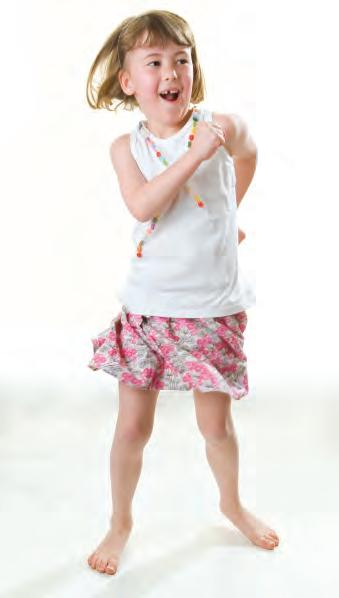
In EYLF, the breadth and richness of a young child’s learning journey is expressed in terms of belonging, being and becoming. In this section, we explore what is meant by these terms and offer snapshots of how the Arts play a role. In the following chapters, we will examine each of these in greater depth.
Belonging
OXFORDUNIVERSITYPRESSSAMPLEONLY
Our sense of who we are and our place in the world—our identity— is significantly determined by our sense of belonging. Central to our sense of belonging are the relationships we have with family, community, place, culture and heritage. Research shows that children who feel connected to others do better in life than children who don’t (Cullerton-Sen & Crick, 2005; Over, 2016).
Carefully designed arts experiences can nurture children’s sense of belonging. For example, children can explore topics such as my family, my friends, looking after my pets, our team, our classroom. They can do this by working with clay, drawing, taking photographs or engaging in dramatic play. They can place their own experiences in the context of artworks by artists and see how others share these interests. They can practise the behaviours of belonging such as sharing equipment and space, taking turns with the tambourines, singing and dancing together, assisting each other, and thoughtfully responding to each other’s artwork.
8 OXFORD UNIVERSITY PRESS PART 1 C H ild RE n’ S lEAR ning THR oug H THE A RTS
FIGURE 1.1 Children require opportunities to interpret the quality of the music through movement.
self- initiated ‘let’s pretend’ play between two or more children.
Being
While early childhood education is preparation for the future it is also about the present and the day-to-day experience of living life—its joys, challenges and complexities.
When we focus on the experiential nature of being in the world, the role of our senses is highlighted. We live in a sensate world, meaning that we receive and process information about the physical world through our senses. These include our sense of sight, hearing, taste, smell and touch—along with about 20 other senses. Many studies have shown that sensory deprivation in the early years has a lasting and deleterious effect on children’s development (Glasper, 2020; Tomalski & Johnson, 2010). In children’s early years, it is particularly important that they experience a full and multidimensional apprehension of their world, and that their sensory capacities are developed (Vygotsky, 2004).
Since the Arts are experiential in nature and engage the senses, learning in the Arts facilitates children’s participation in a sensory world. When they listen to music, they distinguish sound and silence, high and low notes, loud and soft notes. They discover the expressive and metaphorical power of sounds, so that the tinkle of the triangle represents the fairy; the drum beats signal the giant’s steady approach; and the increasing tempo conveys a sense of urgency. Furthermore, guided music appreciation leads to heightened aural discernment , which is a critical capability for language development (so children can hear the subtle difference between ‘pat’, ‘mat’, ‘bat’).
Being in the world is also about being in the socio-cultural world that is shaped by beliefs, values, customs and behaviours. Through drama activities, children can explore the dynamics of relationships and social experiences. In the safety of ‘let’s pretend’ they explore diverse societal roles (such as mothers, doctors or fire officers) and scenarios that present challenges to be addressed (such as three friends have found a lost puppy who has a collar but no name tag).
Viewing paintings and listening to music transports children to other worlds of experience. They can engage with diverse conceptions of motherhood by exploring PierreAuguste Renoir’s Child with Toys—Gabrielle and the Artist’s Son Jean (1895–96), Patricia Piccinini’s The Young Family (2002), and Julie Dowling’s Black Madonna: Omega (2004) (see Figures 1.2, 1.3 and 1.4). They can be stirred by the heroic sounds of Beethoven’s 5th Symphony (1808) or soothed by the mellow notes of Schubert’s Trout Quintet (1819). In well-designed arts experiences, qualities such as wonderment, curiosity, imagination and creativity are nurtured. Children explore their world by experimenting: What happens if I do this? They create: I want to put this with that. They reflect: I like that one more than the other one. The sensory dimension of the Arts means that children are invited to explore and learn in a haptic way (moving, touching, doing) and in a visual way (viewing, observing) and by using their auditory faculties (listening, hearing). Through Dance, Drama, Media Arts, Music and Visual Arts, children apprehend, construct and express their experiences— their reality—and the fact of their being in the world.
OXFORDUNIVERSITYPRESSSAMPLEONLY
Becoming
Newborn babies are extensions of their mothers but they quickly develop their sense of agency. This means they make things happen—a baby slaps its hand on the table and makes a sound happen. When toddlers exercise the power of ‘no’, it can be exasperating for parents, but it signals the child’s growing sense of being able to control or influence their world— their agency.
aural discernment
The ability to distinguish different sounds such as sounds of speech, music and environmental sound.
9 OXFORD UNIVERSITY PRESS CHAPTER 1 S ETT ing THE Con TE x T
OXFORDUNIVERSITYPRESSSAMPLEONLY
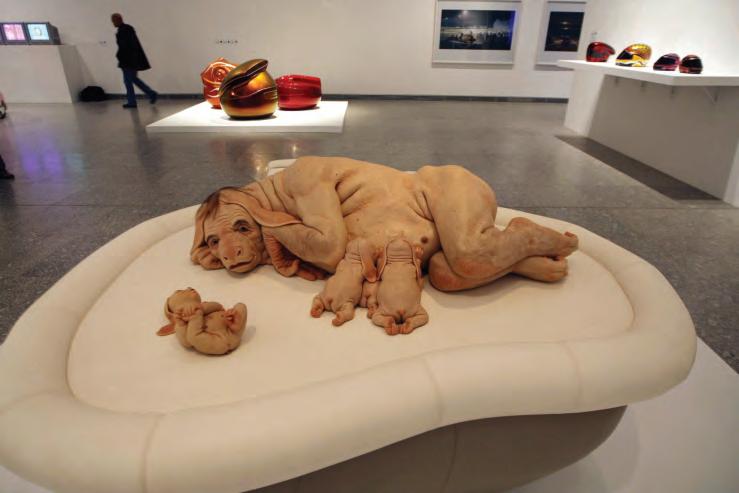
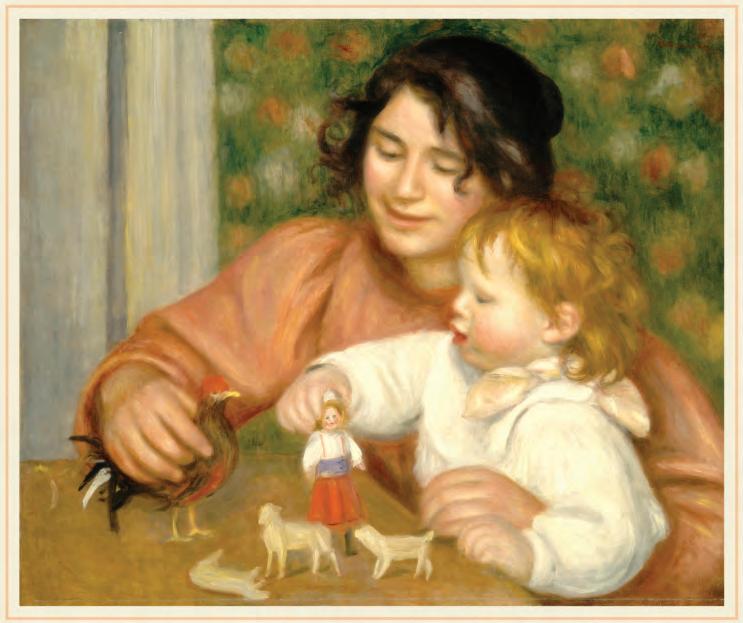
10 OXFORD UNIVERSITY PRESS PART 1 C H ild RE n’ S lEAR ning THR oug H THE A RTS
FIGURE 1.2 Auguste Renoir (1841–1919). Child with Toys—Gabrielle and the Artist’s Son, Jean , 1895–96. 54.3 × 65.4 cm. Oil on canvas.
FIGURE 1.3 Patricia Piccinini (1965–). The Young Family , 2002. 85.1 × 149.9 × 120 cm. Silicone, fibreglass, leather, human hair, and plywood.
Throughout their childhood, children are engaged in developing agency. They are becoming autonomous individuals and learning how to participate responsibly as individuals in society. This is the process of identity formation—of becoming—and is regarded as one of the major projects of childhood (Erikson & Erikson, 1998).
To be sustained in this journey of identity formation, children require opportunities and interactions that foster and affirm their sense of self: they need to experience that their thoughts, ideas and needs are considered, their creations are valued, their findings and opinions are respected and their cultural backgrounds are reflected back to them.
The Arts, by their nature, provide a learning context for children’s expression of their own perceptions, ideas, thoughts and feelings. Children can paint their response to a piece of music or create a dance for the night. Drama experiences enable them to ‘try out life’ by being involved in activities where they experience diverse roles and situations. They can be both a mighty king and a lowly peasant; they can escape from the invaders; they can climb the beanstalk to the giant’s place or they can transact shopping at the supermarket. The world of art also provides a rich venue for exploring cultural diversity, similarities and difference. In the process, children can learn how to live together, how to respectfully engage with others, how to overcome obstacles and how to enjoy life. As children imaginatively invent and project themselves into various scenarios and possibilities they are engaged in their becoming.

OXFORDUNIVERSITYPRESSSAMPLEONLY
11 OXFORD UNIVERSITY PRESS CHAPTER 1 S ETT ing THE Con TE x T
FIGURE 1.4 Julie Dowling (1969–), Badimaya people. Black Madonna: Omega, 2004. 120 × 100 cm. Synthetic polymer paint, red ochre, glitter and metallic paint on canvas.
Source: Art Gallery of Western Australia collection, Perth. Image courtesy the artist and Art Gallery of Western Australia, Perth © Julie Dowling
EYLF elements: Principles, Practice, Learning Outcomes
To address children’s education in relation to their belonging, being and becoming, EYLF is designed around three elements: Principles, Practice and Learning Outcomes. The Principles are shared understandings about the nature of learning and early childhood pedagogy that underpin Practice, which are the approaches taken by educators to shape children’s learning experiences with a view to achieving the intended Learning Outcomes. Even if you work outside the Australian context, the ideas expressed in EYLF are widely accepted as relevant to early childhood learning in the contemporary world. In this section, we illuminate these elements with reference to examples within the Arts.
How the Principles are enacted within meaningful arts experiences
1 Secure, respectful and reciprocal relationships : In a network of ‘relationships of trust’, a strong sense of wellbeing and self-confidence is engendered in children and this provides a solid foundation for learning.
When engaged in art-making, children have many opportunities to experience the dynamics of teamwork, behave cooperatively and learn collaboratively. In groups, they can create dances. They can take roles in dramatic play to act out their stories. They can share equipment, take turns being the photographer and support each other’s efforts through encouragement.
When children observe that time has been allocated for art-making whereby their paintings are displayed, resources for exploring music are provided and opportunities to show others what they have been dancing are incorporated into the program, they instinctively know that their artistic undertakings and expressions of feeling and ideas are valued (Yates & Szenasi, 2021). They see that they themselves are valued.
OXFORDUNIVERSITYPRESSSAMPLEONLY
2 Partnerships : The family is the first and most influential teacher of young children. When an early childhood educator approaches a child’s parental figures as partners in the child’s education, the shared insights and perspectives about the child’s needs, motivations and learning provide a platform for dynamic and coherent education that extends from the home to the educational setting. Many parents will not have an educator’s understanding of how arts experiences are important ways in which children create meaning and develop their sense of self and their place in the world. When teachers share this knowledge and parents learn the educational value of these experiences, they are able to reframe children’s arts-making activities in the home to achieve the full benefits they can provide. Similarly, the early childhood educator can weave knowledge of the home context into arts experiences to heighten the relevance of the activities. For example, a child’s love of chickens can be the basis for a movement activity that requires close observation of chickens’ actions. Parents can bring their arts skills and traditions into the early childhood educational setting too. Having a parent teach a traditional dance or play the accordion to accompany children’s singing reinforces the idea that education and art are integral dimensions of life.
12 OXFORD UNIVERSITY PRESS PART 1 C H ild RE n’ S lEAR ning THR oug H THE A RT S
3 High expectations and equity : In education that is focused on children’s learning achievement, the idea of equitable learning opportunities is fundamental. ‘Equitable’ means that everyone has the types of learning experiences that enable them to shine and make the most of their potential.
In arts experiences (with their focus on discovery, invention and meaning-making), each child is on their own learning journey. Each child’s response to a stimulus will be uniquely their own. With no prescriptive or predetermined outcome, each child’s learning can be individualised. The degree of challenge or the focus can be tailored to suit their individual needs, interests and abilities.
The Arts represent a cluster of different languages for expression. Children can respond to a stimulus, such as a walk through a flower garden, using different processes like drawing, painting, modelling in clay, creating digital storybooks, dancing, or composing music. This flexibility contributes to equity since it enables each child to find the language or artform that suits their particular desires, interests and skills. Contemporary Arts education conceptualises children’s artistic learning experiences as multidimensional. Children’s art-making occurs across diverse artistic forms (dance, drama, media arts, music and visual arts) and is complemented by reflective practices that encourage contemplation about purpose, achievements and learning strategies. It is underpinned by attention to craftsmanship and developing understandings of the Arts languages and the work of artists. This comprehensive view of arts learning embeds equitable learning opportunities and high expectations about children’s engagement and learning.

stimulus
An event, activity or thing that provokes engagement, such as the act of painting, a story, an object or music that is used to initiate children’s interest. Also catalyst or provocation
OXFORDUNIVERSITYPRESSSAMPLEONLY
composing
A process of creative invention where a musical sequence is created. Composing can evolve within the process of singing or playing, or be a more formal process where ideas are worked through and refined.
13 OXFORD UNIVERSITY PRESS CHAPTER 1 S ETT ing THE Con TE x T
FIGURE 1.5 Water puppetry shows in Vietnam originated in rice paddies where they were performed to celebrate the harvest.
kinaesthetic
Refers to movement. Dance is a kinaesthetic art form because it involves moving the body.
4 Respect for diversity : Each child you meet in a formal educational setting already belongs in a family and cultural milieu that have inculcated ways of being in the world: behaviours, relationships, values, beliefs and ways of knowing. Respect for diversity involves honouring diverse ways of being in the world—and reflecting this back through curriculum content and educational practices. For Australians, this notably includes Aboriginal and Torres Strait Islander peoples’ ways of being and knowing.
A significant way in which diversity is expressed is through the artistic practices and traditions of individuals, groups and cultures. Exploring the artworks, artistic practices and artistic traditions of artists, groups and cultures across time and place is an engaging and valuable way in which children learn the ways we are different and yet the same.
Pause and reflect
PUPPETRY TRADITIONS REFLECT CULTURAL DIVERSITY
Puppets are part of the arsenal of childhood: finger puppets, sock puppets, glove puppets and many more besides. A collection of puppets is a popular feature in the early learning centre because children are instinctively drawn to them. The puppets facilitate secure and safe interactions, activate children’s imaginations and add a kinaesthetic dimension to storytelling.
Children’s experiences with puppets are the basis for making connections to the wider world of puppetry—a widespread theatrical tradition that dates back thousands of years. Across time and space, distinctive cultural variations have emerged. Exploring the different puppetry traditions not only opens up a world of wondrous delights, it also offers children insights into the diverse nature of peoples’ lived experiences. The water puppet theatre tradition of the Mekong in Vietnam is different from the Wayang Kulit shadow puppet theatre of Indonesia, the Bunraku puppet theatre of Japan, the Hun Krabok of Thailand and the Black Light puppet theatre of the Czech Republic. Their differences reflect the contexts of their creation. For example, Vietnam water puppetry was initially performed in the water of the rice paddies to celebrate the harvest (see Figure 1.5). A pagoda was constructed to hide the puppeteers and the water acted as the stage, while also concealing the mechanisms of the performance and symbolically linking to the life-giving waters. As an artform, it is fundamentally linked to a world where people worked in the water of the rice paddies.
OXFORDUNIVERSITYPRESSSAMPLEONLY
Can you think of other artistic traditions that have different cultural expressions around the globe? Masks? Theatre? Beadwork?
5 Ongoing learning and reflective practice : The EYLF reflects the principles of constructivism—a theory of learning based on the idea that children learn from experience and participation in their own learning rather than from being passive recipients of information (Lake, 2012). In this learning model, the educator’s role is to facilitate children to be active and reflective learners by empowering them to find their own answers through their own investigations. This is a qualitatively different approach to one based on instructing or drilling students. When facilitating children’s
14 OXFORD UNIVERSITY PRESS PART 1 C H ild RE n’ S lEAR ning THR oug H THE A RT S
inquiry-based learning, educators are required to observe the dynamics of the learning unfolding in the learning space and adapt or scaffold learning in ways that are responsive to children’s needs. This means that programs and pedagogy are constantly being refined in a dynamic process of reflection and review.
Contemporary arts education is orientated towards children exploring and finding creative solutions to arts-based challenges—and being initiators and active participants in learning. The focus on individuals and their learning journeys requires educators to be engaged and reflective professionals both in the moment and in an ongoing cycle of review.
How the aspects of Practice are integral to meaningful arts pedagogy
The EYLF Principles underpin an educator’s Practice. In this section, we examine how the eight aspects of pedagogical practice identified in EYLF as necessary for good-quality learning are congruent with understandings about contemporary teaching and learning through the Arts.
1 Educators adopt holistic approaches : The core concept underpinning a holistic approach to education is that the whole person is educated: their cognitive, physical, social, emotional and spiritual being. A holistic approach recognises that children are developing as people and that different aspects of their being are developing simultaneously. A holistic approach also recognises that this development is occurring within children’s physical environment and the socio-cultural context of their family, community, and culture. Therefore, early years learning and educational practices are multidimensional, integrated, interconnected and interdependent. We see that good-quality learning through the Arts sits within a holistic approach to pedagogy. The Arts typically engage the whole child through the very nature of arts experiences as well as the ‘topics’ for exploration. For example, when children listen to music and then interpret the rhythms, beat and feeling of the music through dance movement they are engaged holistically.
2 Educators are responsive to children: In EYLF, each child is viewed as a competent learner and is positioned at the centre of their own learning journey. As active agents in their own learning, children participate directly in learning experiences and discovering things for themselves; they initiate and contribute to the direction of their learning. In this model, the educator’s role is to facilitate each child on their own learning journey by building on the child’s interests and motivations (such as music or dinosaurs) and competencies (such as being bilingual, self-sufficient or athletic). The mantra ‘follow the learner’ is a useful guide for this approach.
OXFORDUNIVERSITYPRESSSAMPLEONLY
3 Educators promote learning through play : The EYLF builds on children’s natural learning behaviours and has adopted a play-based pedagogy (Bruce, 2012). Play-based learning is serious business. When play is promoted within an educational context it should not be dismissed as frivolous amusement, time out or relaxation. While there are different interpretations of play-based learning, the overarching principle is that it is a path to learning determined by children’s interests: a pleasurable experience that occurs in an organic, spontaneous and voluntary way as children are invited to explore, test, hypothesise, narrate and imagine possibilities (Ginsburg, 2007; Hirsh-Pasek et al., 2009). In play-based learning, early childhood educators do not have a prescribed set
15 OXFORD UNIVERSITY PRESS CHAPTER 1 S ETT ing THE Con TE x T
Pause and reflect LEARNING PROMOTED ‘IN THE MOMENT’
A young child picks up and studies a fallen leaf. The teacher, Mr Zagari, picks up another leaf and says, ‘Here’s another one that looks different. I think the wind blew these to the ground. I wonder how many others can be found.’ The child gathers more leaves and after a while Mr Zagari observes, ‘These two leaves are round and look different to the others.’ The child considers this and begins to separate the leaves into piles depending on their shape. The teacher asks, ‘What shape are the leaves in this pile?’ and listens to the child’s responses before asking if they can find that shape somewhere else in the playground. The child is not particularly interested in this proposition and instead begins arranging the leaves on the pavement to create patterns. Mr Zagari comments using the word ‘pattern’. After a while, observing that the child’s interest has begun to wane, he says, ‘I know a way you can print leaf patterns on paper, would you like me to show you?’
The responsive educator has engaged with the child in the moment to extend their interest and guide their learning. Observing the child’s interest in the leaf the teacher introduced observing and selecting a variety of leaves, identifying the characteristics of different shapes, categorising based on shape, identifying the same shapes in other categories of objects, creating patterns using shapes, using words related to shape and pattern, and introducing a printing process that encourages the child to extend their interest and application of new knowledge. What conceptual understandings has the child exercised in the process?
of lessons to work through. They follow the learner and shape learning opportunities around a child’s interests and activities. In order to be educationally effective, they have to be perceptive observers, agile thinkers and responsive to the possibilities for extension and development of each child’s playful learning.
OXFORDUNIVERSITYPRESSSAMPLEONLY
Contemporary thinking about arts education promotes the idea of children developing their own responses to open-ended challenges or propositions: How can we use these materials to make puppets for your story? When children engage in arts experiences they are involved in the processes of investigation and imaginative creation, and ‘learning by doing’. They are at the centre of their learning and their knowledge, insights or understandings emerge from their experience of the process. Once again, the educator has to be perceptive, agile and responsive to the learning possibilities inherent in each child’s art-making endeavours.
4 Educators are engaged in intentional teaching : In a flexible and dynamic learning environment, the educator uses a range of teaching procedures to facilitate learning. This means that they must be alert to the unfolding context and intentionally use procedures like open-ended questions or demonstrations to facilitate learning. Conversations with children happen naturally in the day, but a skilled educator
16 OXFORD UNIVERSITY PRESS PART 1 C H ild RE n’ S lEAR ning THR oug H THE A RT S
ensures that conversations develop in ways that promote learning. In good-quality arts education, worthwhile interactions can be built around children’s engagement in arts-making. This would be to facilitate their investigations, decision-making and reflections on their creations and the processes they employed. Similarly, paintings such as Bruegel’s Children’s Games (1560) provide engaging foci for conversations that exercise children’s thinking and observation skills. Using a guided viewing framework that incorporates identifying, analysing and speculating about a painting is one way of intentionally teaching in the Arts.
5 Educators create learning environments that are conducive to learning : The design of indoor and outdoor spaces invites different types of usage. For example, an outdoor space filled with a variety of plants, paths, sandpit, seating, lawn and shady trees invites a range of ways to be outside that are not offered in an open yard surfaced with bitumen and devoid of trees. Good learning environments are ones that are welcoming and invite children’s play-based learning, risk-taking, inquiry and investigation, creativity and imaginative invention.
Wit hin spaces, the various provisions also telegraph different types of messages about what children are encouraged to do in the space. Investigations and explorations are encouraged by the provisions that are made: a ‘discovery table’ of interesting items such as shells and seed pods; ‘play boxes’ containing items that can be used in dramatic play; boxes of machinery parts and tools for making constructions; a music centre with musical recordings, improvised and conventional instruments; and an art studio space with facilities for painting and working with clay.
The lea rning environment is a social space as well as a physical one. Organising spaces that facilitate group activity, independent investigations and opportunities to practise social behaviours (such as applauding at the end of a performance, listening quietly when someone is talking, taking turns with equipment and discussing ideas with others) are ways that the social dimension of the environment is constructed to support learning. Similarly, flexible schedules and availability of materials contribute to shaping a learning environment conducive to young children’s learning practices. Displaying children’s creations—their drawings, paintings and sculptures— acknowledges their significance. The role of these creations in the learning process is highlighted when these are contextualised. For example, children’s drawings and clay sculptures of a visit to the zoo are displayed with photographs taken at the zoo, a map of the path taken past the enclosures, pamphlets and key words.
6 Educators demonstrate cultural competence : Children’s cultural context is integral to their sense of self—their being and belonging. Honouring this helps children flourish as individuals. We live in a multicultural society and generally each classroom and early childhood centre is a microcosm of our broader society. Being culturally competent means being comfortable with cultural diversity and the diverse ways of being in the world. It involves understanding and respecting the diversity of beliefs, values and practices. It also means being able to effectively communicate and interact with people from a diversity of backgrounds. Contemporary educators can model this in their own behaviours and practices as well as in the nature of the learning environment they create for children and the efforts they make to develop children’s own cultural competence.
OXFORDUNIVERSITYPRESSSAMPLEONLY
17 OXFORD UNIVERSITY PRESS CHAPTER 1 S ETT ing THE Con TE x T
chants
Rhythmic word patterns, for example, Rain, listen, listen, listen to the rain, listen, listen; Run, run, as fast as you can; Eeny meeny miny mo.
Every culture has artistic traditions and practices that embed cultural beliefs and va lues. Exploring the artistic traditions of diverse cultures provides a valuable way of embracing children’s cultural backgrounds and developing children’s understanding of the diversity of the world in which they live. Like all art forms, songs are social and cultural practices that relate to places, times, cultures and events. When singing songs from around the world, the efforts made to contextualise the song in its cultural milieu will contribute to children’s developing understanding of these things. Hamabe no Uta, for example, is a Japanese folksong about memories that can prompt identifying Japan as a country, discovering the Japanese language and holding a discussion about special memories. The Afro-American spiritual Walk Together Children is a song of solidarity encouraging a community of people to stay strong together for a better day ahead. Children can learn how the song originated during the American Civil War with its promise of freedom from slavery. They may also consider how the song’s overarching theme of solidarity or mutual dependence applies in their own lives (Bigsten, 2012).
7 Educators provide continuity of learning and transitions : Young children face several milestone transitions from the family environment to an early childhood centre to a pre-primary or kindergarten and to Year 1 in a school environment. Each setting has its own traditions, routines, practices, social structures and personnel. For the child, each transition represents a change in their sense of self: their relationships, role and position (Cowan et al., 2005). These are vulnerable times for children and helping them feel secure, confident and included through each transition is important for their continuing development (Sayers et al., 2012). Part of this involves communication and arrangements between parents, teachers and educational sectors; but much can be done with children to ease them through these transitions. Research shows that the more children are independent, culturally and socially competent, the more positive the transitions will be (Davies, 2011; Dockett & Perry, 2007; Margetts, 2007).
Chi ldren experience transitions every day as they transition, for example, from one activity to another. Rituals and procedures for managing transitions establish patterns that can be translated into managing other transitions. For example, marking daily transitions with transition songs and chants helps to denote a change as an occurrence in the day. A transition song about the time of day introduces the notion that time on the clock is relevant to what is happening. Engaging children in the Arts creates many concrete contexts for children to experience and examine the nature of transitions and to develop the skills to negotiate transitions happily.
OXFORDUNIVERSITYPRESSSAMPLEONLY
Chi ldren’s books like Owen and Wemberly Worried (both by Kevin Henkes) feature mice characters who have worries about starting school. Books like these can provide the basis for discussion, creating drama, or painting pictures about the characters and how they go on to thrive—or about children’s equivalent concerns.
When children participate in visits to their future location (such as a nearby primary school), sessions where children draw their experiences, take photographs or create videos about the experience can provide the basis for conversations about matters of concern such as where the toilets are located (Dockett & Perry, 2014).
The material and process base of many visual arts activities provide a context for children to learn about procedures and sequences, and about responsibilities such as collecting equipment and cleaning up. Developing social skills (such as working together, taking turns and sharing) are practised in drama activities, singing and
18 OXFORD UNIVERSITY PRESS PART 1 C H ild RE n’ S lEAR ning THR oug H THE A RT S
playing music together, creating group murals and media productions, as well as reflecting on and reviewing the artworks created by others. These all contribute to developing children’s social competency, which in turn strengthens their ability to manage transitions effectively.
8 Educators assess and monitor learning to achieve learning outcomes : Through assessments and related strategies for monitoring learning, educators and other stakeholders gather information about how children are progressing. This provides the basis for future plans and directions.
When children are engaged in the Arts, their thought processes, conceptual development and manual skills are on display. A child mixing different amounts of yellow and blue to create different shades of green is discovering and displaying knowledge about colour and the role that proportion plays in modifying it. Chi ldren advance through a predictable sequence of drawing stages as a natural part of their development (Lowenfeld, 1947; Malchiodi, 1998). While children’s drawing and paintings are often unintelligible to adults, they are the manifestations of thinking or stories that young children can recount in some detail. Similarly, Dance, Drama, Media Arts, Music and Visual Arts provide important vehicles for young children to make their view of the world, understandings, thoughts and ideas visible.
A ski lled observer can identify the conceptual understandings, social engagement and emotional intelligence on display in a child’s art-making. They know that a child’s artwork is a catalyst for conversation and an effective way of gaining insights into their learning. Simply asking a child to tell you about their drawing will reveal the child’s rich thinking. Similarly, observing how children arrive at decisions on shared projects, take turns with equipment and support each other’s artistic enterprises by making helpful suggestions will provide tangible evidence of their developing social competencies.
Addressing the Learning Outcomes within Arts experiences
Learning and the development of the whole child is complex and multidimensional. The EYLF aims to capture this in its five learning outcomes. The Arts investment in imaginative play, dramatic play, storytelling, creative invention and construction, self-expression, critical reflection and artistic appreciation means that all five learning outcomes can be productively addressed through good quality arts engagement.
1 Children have a strong sense of identity : With a strong sense of identity or self-concept, children develop an inner confidence. A sense of identity encapsulates children’s physical, social, cultural, spiritual and psychological selves; and is shaped by children’s experiences, the relationships they have with the people around them, and the context within which they live. Through positive experiences children develop resilience, autonomy, solidarity and an awareness of their own agency. They feel valued by others and are safe and secure. They are able to show care, respect and empathy for others. Role-playing community service roles, creating emotion masks, singing together, engaging in a guided viewing of portrait paintings, and creating dramatic enactments of animal family stories are representative of the diverse ways in which children can engage in arts activities that contribute to their developing self-concept.
OXFORDUNIVERSITYPRESSSAMPLEONLY
catalyst
Something which is introduced to generate interest and focus for the learning experience that is about to unfold.
19 OXFORD UNIVERSITY PRESS CHAPTER 1 S ETT ing THE Con TE x T
2 Children are connected with and contribute to their world: When children have a secure sense of their own identity and are confident in themselves and their place in the world, they are able to connect and participate in an increasingly variety of contexts and relationships. As children grow, they become more aware of how their actions affect others and their environment. They develop understandings and practices associated with fairness and respect for diversity. They learn about traditions, heritage and shared histories. When children play together and participate in collaborative learning situations, they see how their lives are connected to others, how people live interdependently and how social behaviours and protocols sustain this. They see how they contribute to a shared existence through their actions and decisions. Art s activities are physical endeavours involving children directly in the world of cause and effect. Children experience the consequences of their actions. As forms of communication, a child’s relationship with others is exercised through art-making and responding. The Arts also represent diverse ways of knowing and being in the world. When children participate in arts-making experiences and contemplate the artworks they and others make, they are drawn into a rich and diverse world of human experience, which supports their developing sense of connection and awareness of others and their environment.
3 Children have a strong sense of wellbeing : Children’s wellbeing encapsulates their physical and psychological equilibrium—their happiness, satisfaction, self-regulation, social functioning and physical health. Further, wellbeing is highly correlated with children’s ability to concentrate, their resilience and perseverance, social adjustment and overall success at school (Bagdi & Vacca, 2005; Pollard & Lee, 2003). There is extensive evidence that wellbeing is enhanced through participation in the Arts (Bungay & Vella-Burrows, 2013; Cameron et al., 2013; Oreck, 2004; Ruppert, 2006). In the early childhood centre or classroom, there are many ways this can occur. For example, when children are taught to sing, the attention given to posture, breathing and focus all help their physical wellbeing. Singing enables emotions to be released or expressed—and as air is pumped into the lungs, the flow of endorphins improves mood. Singing in a group is a cooperative (rather than competitive) enterprise that creates camaraderie and recognition that each individual depends on the others in the group. Shy children are embraced in the joint endeavour and this provides a space for their confidence to develop. The songs themselves can promote life skills with messages about good nutrition or being good friends (Klopper & Dachs, 2008).
OXFORDUNIVERSITYPRESSSAMPLEONLY
A positive effect on children’s equilibrium is also achieved by the experience of ‘captivation’ or immersed absorption associated with creative pursuits (McCarthy et al., 2004).
4 Children are confident and involved learners : When children are actively involved in their own learning, they develop strategies for undertaking explorations, confidence to experiment, and enthusiasm for problem-solving activities. Their learning dispositions such as curiosity, wonderment, imaginative thinking, creativity, persistence and tolerance of risk are nurtured. As they practise envisioning and predicting, pondering, reasoning and testing propositions they become increasingly able learners. They see how learning in one context can be applied in another. They assemble resources and test hypotheses. They see ‘failure’ in an inquiry-learning framework as a step in the
20 OXFORD UNIVERSITY PRESS PART 1 C H ild RE n’ S lEAR ning THR oug H THE A RT S
process of arriving at the desired outcome. As confident and involved learners, they are motivated by the intrinsic rewards of learning.
The natu re of arts learning is recognised as distinctive with a major study of highly successful visual arts classrooms, leading to the distillation of eight ‘studio habits of mind’ (Hetland et al., 2007) that represent the thinking strategies exercised when children are engaged in the visual arts studio. The Hetland study and another threeyear study (Oreck, 2004) determined that learning dispositions developed in arts learning experiences could be productively employed across the curriculum to promote the learning dispositions associated with inquiry-based learning (see Chapter 3).
5 Children are effective communicators : Children can communicate verbally and nonverbally. They can communicate thoughts and ideas using their bodies when dancing, through sound when composing music or singing or through imagery, as well as understanding meanings being communicated by others in a range of media. In the digital world, the increasing prevalence of multimedia formats strengthens the need for children to be literate in a range of non-verbal and verbal forms of communication. Recognising that Dance, Drama, Media Arts, Music and Visual Arts are forms of expression and communication means that promoting children’s engagement in this range of arts practices develops their capacity to communicate in today’s world.
The Arts Learning Area in the Australian Curriculum
The Australian Curriculum and EYLF are based on different educational paradigms. The EYLF presents early childhood education in terms of children’s holistic development and as a matrix of principles, practices and overarching learning outcomes. The Australian Curriculum presents learning primarily in terms of content—the capabilities and understandings within each Learning Area to be developed in each year of schooling through the program provided in the classroom.
The Australian Curriculum is being implemented differently in the different states and territories, but the overarching concerns and directions remain the same.
Core concepts
The curriculum of the Arts Learning Area is designed to provide intellectual, emotional and sensory experiences that develop children’s capabilities and understandings. These revolve around expressing ideas, thoughts and feelings through the Arts and involve thinking creatively, developing skills with arts processes and materials, engaging in critical and reflective thinking, and sharing or performing. These ideas are captured by two core concepts (see Figure 1.6). These are that children participate in the Arts in the roles of artists and audiences and they do this by engaging in arts-making and arts-responding activities. We can think of arts-making as learning by being an artist and arts-responding as learning by being an audience. While presented separately, these roles and types of engagement are typically interconnected and interwoven in practice.
The core concepts are the foundation of arts education. These concepts are enacted through the content strands outlined in the curriculum documents.
arts-making
‘Making in each Arts subject engages students' cognition, imagination, senses and emotions in conceptual and practical ways and involves them thinking kinaesthetically, critically and creatively’ (ACARA, 2014).
arts-responding
OXFORDUNIVERSITYPRESSSAMPLEONLY
One of the two organising strands of the Australian Curriculum. It refers to the dimension of arts learning related to reflecting on and reviewing artworks— children’s own artworks, the artworks of their peers or artistic traditions and the artworks of acclaimed artists.
21 OXFORD UNIVERSITY PRESS CHAPTER 1 S ETT ing THE Con TE x T
Children are engaged in Making and Responding
Children learn in the roles of Artist and Audience
Children’s learning involves Content strands
The artist engaged in arts-making
While young children can be kept busy with colouring-in activities and the like, this is not representative of learning in the Arts. Instead, arts-making focuses on artistic challenges that are explored, developed and resolved as artworks that communicate the creator’s ideas, thoughts or feelings (Wallas, 1926). This is a critical concept as it moves art-making beyond busy work or cookie-cutter art activities where everyone makes the same thing—and emphasises children’s meaningful, imaginative and creative engagement in investigations and problem-solving challenges where their individual artistic interpretations are encouraged and celebrated.
The Arts are recognised as forms of praxis—they are enacted—and learning or knowing achieved within the process of ‘doing’ (Gauntlett, 2011). This makes art-making an emergent process because the individual ‘comes to know’ or discovers or learns through their engagement and trust in the experience. For example, when children experiment filling jars with different amounts of water and then tapping them, they are participating in a learning process where they will come to know the possible sounds that can be made by adjusting the water content.
When involved in art-making, children are learning as artists. They will use arts knowledge, along with a variety of arts skills, techniques, processes, materials and technologies to design, produce, present and perform artworks that communicate their intentions (ACARA, 2014). If arts-making experiences are well-designed in accordance with the curriculum expectations, they will provide rich learning contexts that engage children in:
• experimenting
• conceptualising
• problem-solving
OXFORDUNIVERSITYPRESSSAMPLEONLY
• decision-making
• interpretation
• reflecting
• refining
• presenting
• performing
• communicating
• evaluating (ACARA, 2014, p. 8).
22 OXFORD UNIVERSITY PRESS PART 1 C H ild RE n’ S lEAR ning THR oug H THE A RT S
FIGURE 1.6 In the Arts Learning Area of the Australian Curriculum, core concepts underpin the content strands.
Core
Exploring and connecting Developing skills, practice and ideas CreatingSharing and
The Arts Curriculum
concepts
communicating
The audience engaged in arts-responding
Arts-responding encompasses children’s involvement in exploring and reflecting on their own artwork and arts-making practices, the artwork of their peers and the artworks, practices and traditions of art-making from diverse cultures in the wider world. In these ways, children play the role of being an audience to their own artworks and the artistic productions of others.
Children reflect on their own art-making in two ways. While they are in the process of creating an artwork they will constantly reflect on its progress and make decisions about what to do next. Alternatively, a formal review at the end of the project is planned to encourage children to reflect on the steps involved in creating their artwork; how these influenced the final outcome; how well their ideas were realised; and how they might take the learning from this experience forward.
Children not only reflect on their own art-making processes and creations, they also review and critically respond to the work of their classmates. They are guided in developing the skills required to do this.
Additionally, as part of their arts education, children are introduced to the work of acclaimed artists and the artworks and arts traditions of diverse cultures. In this way, they build their knowledge about the wide world of art and the way different contexts and motivations influence how, why and what artworks are made. Children develop their arts understanding through considering, analysing, interpreting, appreciating and critically responding to these artworks.
While responding may involve discussion and written responses, it is important to remember that children can respond to an artwork by making artworks themselves. For example, children can respond to music by dancing or painting. Similarly, exploring a painting such as Bailed Up (1895) by Tom Roberts (see Figure 1.7) which depicts bushrangers holding up a stagecoach, can be the prompt for developing a dramatic performance in response to this stimulus.
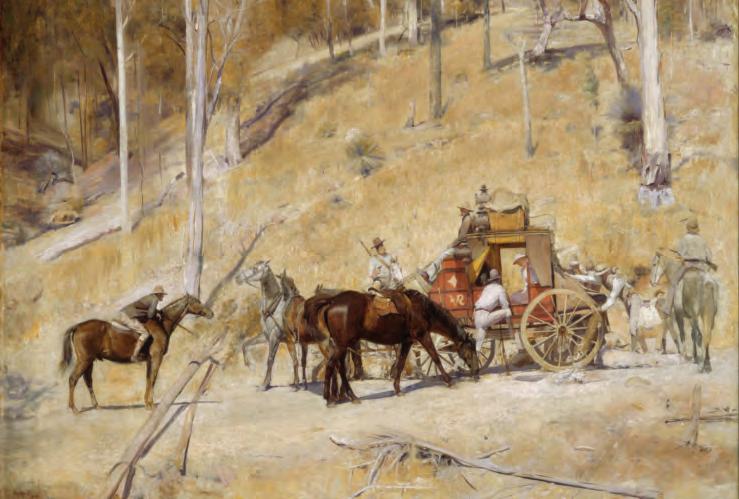
formal review
OXFORDUNIVERSITYPRESSSAMPLEONLY
At the end of a learning experience children contemplate their finished artwork or that of their peers.
23 OXFORD UNIVERSITY PRESS CHAPTER 1 S ETT ing THE Con TE x T
FIGURE 1.7 Tom Roberts (1856–1931). Bailed Up , 1895/1927. 134.5 × 182.8 cm. Oil on canvas.
Art Gallery of NSW
conventions
The generally accepted ways of presenting a particular type of story or type of media product.
improvisation
A drama strategy in which players spontaneously act in role as a character and by doing so learn about that character, for example, playing an art gallery visitor.
Exposure to a diversity of artworks and practices broadens children’s understandings of the world of art, the historical, social, political and cultural circumstances that are the context for artwork—and the possibilities for their own art-making adventures. When responding, children are exercising a range of thinking strategies including:
• exploring
• pondering
• speculating
• reacting
spatial awareness
Being aware of the body in space, either the shape of the body or a group shape.
• analysing
• interpreting
• judging
• critically evaluating (ACARA, 2014, p. 8).
The five subjects in the Arts Learning Area
The Arts Learning Area in the curriculum encompasses five Arts subjects or disciplines. These are:
• Dance
• Drama
• Media Arts
• Music
• Visual Arts.
E ach of these disciplines (or ‘subjects’ as they are known in the Australian Curriculum) has its own history, traditions, conventions and language. Within each discipline, there are different forms that can be explored. Drama, for example, includes role-playing, mime, improvisation and puppetry. Arts-making experiences may involve combinations of arts disciplines so that video projections, music and dance can be combined in a performance. Equally, art-making can be integrated with other areas of the school curriculum (such as storytelling in English); or incorporated into explorations of maths or science concepts like shape, proportion, growth, magnetism.
Types of experiences available in each subject
OXFORDUNIVERSITYPRESSSAMPLEONLY
Each Arts subject offers a wonderful array of art forms and production processes for artistic exploration and expression. Imaginative ways for reflecting upon, considering and responding to artistic creations are part of the learning experience too.
Dance
At the core of dance-making is movement. Young children undertake creative movement explorations and experiments that develop body and spatial awareness. They stretch to touch the sky and scrunch themselves into a small shape that can be wrapped in a parcel
24 OXFORD UNIVERSITY PRESS PART 1 C H ild RE n’ S lEAR ning THR oug H THE A RT S
or move around the room in an imaginary bubble aiming not to touch another bubble and go ‘pop’! In creative dance explorations, children express ideas, concepts and feelings through movement. They can be cats, elastic bands or puppets on strings. They use different motivations for dancing, such as creating a ritual to start the day, or a dance that tells a story about being lost or one that explains the workings of a washing machine. Their dance explorations involve creative thinking, invention and design as they improvise, interpret ideas and choreograph (design) dances. The quality of the execution of dances is developed through practising and refining, rehearsing and performing.
When responding to their own and others’ dance works, children contemplate stories in dances, observe the role of costumes and examine how movements have been used to convey certain feelings. They learn about dance in different contexts—different styles, different motivations, different histories. For example, they may explore the storytelling feature of Aboriginal dances or how the principles of Confucianism that deeply penetrate Korean life are embodied in the serene and fluid movements of traditional Korean court dances and the colours of the costumes (which reflect the five cardinal elements of yin and yang: red/fire, blue/wood, yellow/earth, white/metal and black/earth).
Drama
Dramatic play, short improvisations, role-play, puppetry, play-building and mime are examples of drama forms. Engaging in drama activities, children learn how they can use their voice, facial expressions, gestures and movements to play different roles and tell their stories. They also learn how to create dramatic tension and propel the story forward through the use of drama elements like timing. Improvisations can be vehicles for exploring situations that help children develop empathy and understanding from different perspectives. Rehearsing and presenting performances enable children to experience the magic of the theatrical realm.
When responding to drama, children consider the nature of the characters and situations and make judgments about these—such as what makes the character grumpy or which character most influences the way events unfold; or how the situation relates to their own experiences. They also learn about a range of dramatic traditions and reasons for creating drama such as maintaining cultural stories, entertainment and sharing experiences.
Media Arts
OXFORDUNIVERSITYPRESSSAMPLEONLY
In Media Arts, children create their own media artworks such as comics, photographic stories, posters, digital stories, radio plays, videos and multimedia presentations. In the process, they develop skills using software and digital cameras. They learn how to edit, make sound recordings and combine images, sounds and text to tell stories. They learn to apply conventions such as titles and credits; and how elements such as lighting, language, pace and different camera angles contribute to the storytelling. Importantly, they are engaged in scripting and using planning devices such as storyboards to develop stories with a narrative arc.
Children learn about the range of movie genres such as action, adventure, Westerns and epics as well as examining how diverse cultures represent their stories. They learn that the relationship between producer–media–message–audience underpins the Media Arts.
role-play Involves children in assuming a role so they experience and explore the world by walking in someone else’s shoes or becoming someone or something different. Role-playing is seen in dramatic play, improvisation, Mantle of the Expert, and Story Drama activities.
25 OXFORD UNIVERSITY PRESS CHAPTER 1 S ETT ing THE Con TE x T
A combination and sequence of sounds— and concomitantly, varied periods of silence between the sounds.
Music
Music and movement (Dance) are commonly linked in early childhood education and together create a natural way for children to explore the elements of rhythm, tempo and beat that are integral to both art forms. When involved in music-making, children learn how they can use their voice, body, simple instruments, found sound sources, and digital technology to create music. Their music education includes developing aural discernment so they can discriminate between sounds/silence, loud/soft, high/low, fast/slow. They learn how to compose musical patterns and notate these so others can play them. Singing is a major form of musical engagement and children learn songs from around the world, including those from Aboriginal, Torres Strait Islander and Asian traditions.
Children respond to music by exploring diverse reasons for making music and musical traditions. They listen to music and learn how musical compositions convey different moods, images and feelings. This involves children in talking and writing about music so musical terminology is learnt along the way.
Visual Arts
Materials and fabrication processes feature prominently in Visual Arts as children paint, draw, build with clay, print, dye fabrics, collage, stitch textiles and assemble threedimensional constructions. In the process, children are engaged in developing practical skills and craftsmanship. They also learn about the elements of the Visual Arts such as shapes, lines, colours—and the role they play in conveying meaning. For example, the way the angular black lines outlining the ogre’s facial features make him look fierce.
Children learn about the differences between realistic, expressive, narrative and abstract forms of representation. They review artworks from a variety of cultural traditions, including those from Aboriginal, Torres Strait Islander and Asian cultures, artworks associated with their local community and those that provide prompts for exploring ideas like belonging or sustainability. They contemplate the stories in artworks or the way an artwork makes them feel or they examine how the elements of line, shape and colour play their role.
Summary
OXFORDUNIVERSITYPRESSSAMPLEONLY
The quality of children’s education during the early years (birth to aged eight) is recognised as having a significant effect on their later success in life. The nature of early childhood education is distinguished from formal schooling by its explicit focus on the development of the whole child, and its adoption in the first five years of a play-based learning pedagogy. In the Early Years Learning Framework (EYLF), which is the first national framework for the early childhood sector, this concept of holistic education is expressed as belonging, being and becoming. The Australian Curriculum builds on EYLF, and covers the schooling years from Foundation to Year 3. The Arts is a Learning Area in the Australian Curriculum and all children are involved in arts learning.
Dance, Drama, Media Arts, Music and Visual Arts feature significantly in early years education. They are integral to the natural, active and play-based way that children learn in their early years. In the Australian Curriculum, they are also the subjects within the Arts Learning Area mandated for a child’s schooling.
26 OXFORD UNIVERSITY PRESS PART 1 C H ild RE n’ S lEAR ning THR oug H THE A RT S
musical compositions
The Arts subjects represent ways of knowing that are embodied and experiential. Children’s learning and conceptual development comes from the experience of making artworks using different performing and making processes, and responding to artworks through review, reflection and analysis.
The EYLF and the Australian Curriculum: The Arts, the Melbourne Declaration on Educational Goals for Young Australians, The Alice Springs (Mparntwe) Declaration, the National Quality Standards (NQS) and the Australian Professional Standards for Teachers create the policy and curriculum matrix underpinning the professional role of an early childhood educator.
LEARNING ACTIVITIES
1 Anne Sullivan was the legendary teacher of Helen Keller (who was born both blind and deaf). Re view the quote at the beginning of the chapter and explain what you understand about the distinctions Sullivan is making regarding the two types of learning experiences described.
2 Create an infographic or draw a diagram that captures the way the EYLF Principles, Practices and Learning Outcomes are enacted through the Arts.
3 In a small group, role-play an information session for parents who are visiting your centre or school. The intention of the information session is to explain to the parents (a) the nature of the Arts learning their children will be experiencing and (b) what this achieves in relation to the aims of EYLF or Australian Curriculum: The Arts.
FURTHER LEARNING
• Australian Children’s Education and Care Quality Authority (ACECQA): This is the website of the authority that oversees the implementation of the National Quality Framework for Early Childhood Education and Care. The website includes useful information, videos and updates. http://acecqa.gov.au
• Australian Curriculum, Assessment and Reporting Authority (ACARA). (2014). Foundation to year 10 curriculum:The Arts. Retrieved from www.australiancurriculum.edu.au/the-arts/ introduction
• Australian Curriculum: This is the official website for the Australian Curriculum which establishes what students should be taught in all schools across the country from the Foundation year. The website includes videos showing work samples for arts education. http://australiancurriculum.edu.au
• Australian Institute of Teaching and School Leadership (AITSL): This body is responsible for the development and oversight of the Australian Professional Standards for Teachers. The section for teachers provides information, resources and tools. www.aitsl.edu.au
• Bruce, T. (2012). Learning through play: For babies, toddlers and young children (2nd ed.). Hodder Education.
OXFORDUNIVERSITYPRESSSAMPLEONLY
• Early Childhood Australia: This is a national peak body for early childhood advocacy. The site has a learning hub, resources, publications and an online shop. www.earlychildhoodaustralia.org.au
• Wright, S. (Ed.). (2003). The arts, young children and learning. Pearson Education.
27 OXFORD UNIVERSITY PRESS CHAPTER 1 S ETT ing THE Con TE x T
CHAPTER REFERENCES
Australian Curriculum, Assessment and Reporting Authority [ACARA]. (2014). Foundation to year 10 curriculum:The Arts. Retrieved from www.australiancurriculum.edu.au/the-arts/introduction.
Australian Institute for Teaching and School Leadership. (2012). Australian professional standards for teachers. AITSL.
Australian Institute for Teaching and School Leadership. (2014). Action now: Classroom ready teachers. AITSL. Retrieved from https://docs.education.gov.au/system/files/doc/other/action_now_classroom_ready_teachers_ accessible.pdf.
Bagdi, A., & Vacca, J. (2005). Supporting early childhood socio-emotional well-being: The building blocks for early learning and school success. Early Childhood Education Journal, 33(1) 145–50.
Bigsten, A. (2012). What problems do teachers face when anchoring individualism and solidarity in preschool? In E. Johansson & D. Berthelsen (Eds.) Spaces for solidarity and individualism in educational contexts (pp. 65–82). University of Gothenburg.
Bruce, T. (2012). Learning through play: For babies, toddlers and young children (2nd ed.). Hodder Education.
Bungay, H., & Vella-Burrows, T. (2013). The effects of participating in creative activities on the health and wellbeing of children and young people: A rapid review of the literature. Perspectives in Public Health, 133(1), 44–52.
Cameron, M., Crane, N., Ings, R. & Taylor, K. (2013). Promoting well-being through creativity: how arts and public health can learn from each other. Perspectives in Public Health, 133(1), 52–9. doi: 10.1177/1757913912466951.
Child Rights International Network (CRIN). (2018a). Article 28: Education. https://archive.crin.org/en/home/ rights/convention/articles/article-28-education.html.
Child Rights International Network (CRIN). (2018b). Article 29: Aims of education. https://archive.crin.org/en/ home/rights/convention/articles/article-29-aims-education.html.
Cowan, P. A., Cowan, C. P., Ablow, J. C., Johnson, V. K., & Measelle, J. R. (Eds). (2005). The family context of parenting in children’s adaptation to elementary school. Lawrence Erlbaum Associates.
Cullerton-Sen C, & Crick, N. R. (2005). Understanding the effects of physical and relational victimization: The utility of multiple perspectives in predicting social emotional adjustment. School Psychological Review, 34, 147–60.
Davies, D. (2011). Child development: A practitioner’s guide (3rd ed.). Guildford Press.
Department of Education and Training [DET] (2019). Belonging, Being and Becoming: The Early Years Learning Framework for Australia. https://www.dese.gov.au/national-quality-framework-early-childhood-educationand-care/resources/belonging-being-becoming-early-years-learning-framework-australia.
Department of Education, Skills and Employment. (2019). The Alice Springs (Mparntwe) Education Declaration. Retrieved from https://www.dese.gov.au/alice-springs-mparntwe-education-declaration/resources/alicesprings-mparntwe-education-declaration.
Dockett, S., & Perry, B. (2007). Starting school: Perceptions, expectations and experiences. UNSW Press.
Dockett, S., & Perry, B. (2014). Continuity of learning: A resource to support effective transition to school and school age care. Australian Government Department of Education.
Elliott, A. (2006). Early childhood education: Pathways to quality and equity for all children. Australian Educational Review,50. Australian Council for Educational Research.
Erikson, E. H., & Erikson, J. M. (1998). The life cycle completed. Norton.
Gauntlett, D. (2011). Making is connecting: The social meaning of creativity, from DIY and knitting to YouTube and Web 2.0. Polity Press.
OXFORDUNIVERSITYPRESSSAMPLEONLY
Ginsburg, K. R. (2007). The importance of play in promoting healthy child development and maintaining strong parent-child bonds. Pediatrics, 199(1), 182–91.
Glasper, A. (2020). Sensory deprivation of children living in suboptimal care environments. British Journal of Nursing, 29(6), 376-377. doi.org/10.12968/bjon.2020.29.6.376.
Gordon, A. M., & Williams Browne, K. (2014). Beginnings and beyond: Foundations in early childhood education (9th ed.). Wadsworth.
Heckman, J., Pinto, R., & Savelyev, S. (2013). Understanding the mechanisms through which an influential early childhood program boosted adult outcomes. American Economic Review. 103(6), 2052–86.
Hetland, L, Winner, E, Veenema, S., & Sheridan, K. M. (2007). Studio Thinking: The real benefits of visual arts education. Teachers College Press.
Hirsh-Pasek, K., Michnick Golinkoff, R., Berk, L. E., & Singer, D. G. (2009). A mandate for playful learning in the preschool: Presenting the evidence. Oxford University Press.
28 OXFORD UNIVERSITY PRESS PART 1 C H ild RE n’ S lEAR ning THR oug H THE A RT S
Jay, J. (2016). It’s a question of quality: Resisting the push-down curriculum or maintaining a high standard? Professional Educator, 15(2), 19–22.
Klopper, C., & Dachs, N. (2008). Meeting the goals of Te Whāriki through music in the early childhood curriculum. Australian Journal of Early Childhood, 33(1), 1–21.
Lake, R. (2012). Vygotsky on education. Peter Lang.
Lowenfeld, V. (1947). Creative and mental growth. Macmillan Co.
Malchiodi, C. (1998). Understanding children’s drawings. The Guilford Press.
Margetts, K. (2007). Preparing children for school: Benefits and privileges. Australian Journal of Early Childhood, 32(2), 43–50.
Ministerial Council on Education, Employment, Training and Youth Affairs (MCEETYA). (2008). The Melbourne Declaration on Educational Goals for Young Australians. Retrieved from www.mceecdya.edu.au/ mceecdya/melbourne_declaration,25979.html.
McCarthy, K. F., Ondaatje, E. H., Zakaras, L., & Brooks, A. (2004). Gifts of the Muse: Reframing the debate about the benefits of the arts. The Wallace Foundation. Retrieved from www.rand.org/pubs/monographs/MG218.
Oreck, B. (2004). Enhancing self-regulatory behaviors in the classroom through arts infused curriculum. Ohio Alliance for Arts Education. Retrieved from http://barryoreck.com/articles_self.html.
Over, H. (2016). The origins of belonging: Social motivation in infants and young children. Philosophical Transactions of The Royal Society, B.371(1686). doi: 10.1098/rstb.2015.0072
Pollard, E. L. & Lee, P. D. (2003). Child well-being: A systematic review of the literature. Social Indicators Research, 61(1), 59–78.
Ruppert, S. (2006). Critical Evidence: How the arts benefit student achievement. National Assembly of State Arts Agencies and Arts Education Partnership. Retrieved from www.aep-arts.org.
Sayers, M., West, S., Lorains, J., Laidlaw, B., Moore, T., & Robinson, R. (2012). Starting school: A pivotal life transition for children and their families. Australian Institute of Family Studies, 90, 45–56.
Siraj-Blatchford, I. (2009). Quality Teaching in Early Years. In A. Anning, J. Cullen & M. Fleer (Eds.), Early Childhood Education: Society and Culture (147–57). London: Sage.
Tomalski, P., & Johnson, M. H. (2010). The effects of early adversity on the adult and developing brain. Current Opinion in Psychology, 23(20), 233–8. doi: 10.1097/YCO.0b013e3283387a8c.
Vygotsky, L. S. (2004). Imagination and creativity in early childhood. Journal of Russian and East European Psychology, 42(1), 7–97.
Wallas, G. (1926). The art of thought. Harcourt Brace.
Wood, E., & Attfield, J. (2005). Play, learning and the early childhood curriculum (2nd ed.).Sage Publications.
Yates, E. & Szenasi, J. (2021). Positioning children as artists through a ceramic arts project and exhibition: Children meaning making. European Early Childhood Education Research Journal, 29(2), 303–18. doi.org/10. 1080/1350293X.2021.1895267.
OXFORDUNIVERSITYPRESSSAMPLEONLY
29 OXFORD UNIVERSITY PRESS CHAPTER 1 S ETT ing THE Con TE x T








































